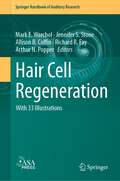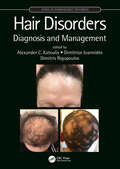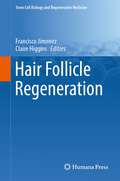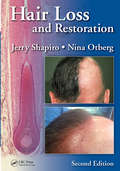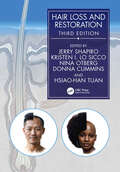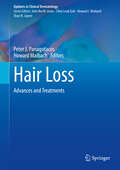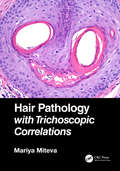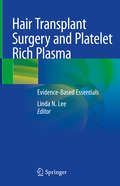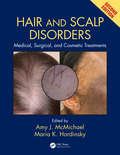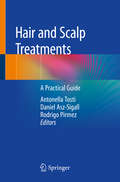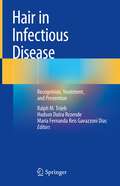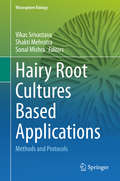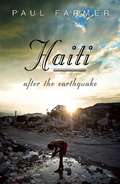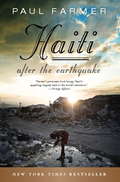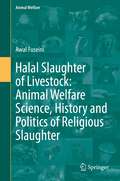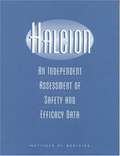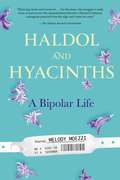- Table View
- List View
Hair Cell Regeneration (Springer Handbook of Auditory Research #75)
by Arthur N. Popper Richard R. Fay Allison B. Coffin Mark E. Warchol Jennifer S. StoneThis volume provides a detailed update on progress in the field of hair cell regeneration. This topic is of considerable interest to academicians, clinicians, and commercial entities, including students of auditory and vestibular neuroscience, audiologists, otologists, and industry, all of whom may have interest in hair cell regeneration as a potential future therapy for hearing and balance dysfunction. In 2008, Springer published a SHAR volume on this subject (Hair Cell Regeneration, Repair, and Protection, Editors Richard Salvi and Richard Fay). Since that time, there has been considerable advancement in this field.This book provides a historical perspective on the field, but the emphasis is on more "prospective" views of the various facets of regeneration research, in the hope that the volume will stimulate new projects and approaches, focusing on the limitations of current knowledge and describing promising strategies for future work. The book will include the following key features of hair cell regeneration: • Cellular and molecular control hair cell regeneration in non-mammalian species (in particular zebrafish and chickens) • Our current understanding of the capacity for hair cell replacement in mammals (rodents and humans). • Signals controlling pro-regenerative behaviors in supporting cells, the hair cell progenitors. • New techniques that have been applied to study the genetic and epigenetic regulation of hair cell regeneration in mammals and non-mammals. • Contributions of stem cells toward building new tools to explore how hair cell regeneration is controlled and toward developing cells and tissue for therapeutic transplantation. • Studies that have applied gene and drug therapy to promote regeneration in mammals.
Hair Disorders: Diagnosis and Management (Series in Dermatological Treatment)
by Dimitris Rigopoulos Alexander C. Katoulis Dimitrios IoannidesA comprehensive resource for the practicing dermatologist on how to diagnose and manage the range of hair disorders in patients. Extensive illustration accompanies each condition and shows the results of the latest diagnostic tools, including dermoscopy.
Hair Follicle Regeneration (Stem Cell Biology and Regenerative Medicine #72)
by Francisco Jimenez Claire HigginsThis book aims to comprehensively review the current cell-based strategies under investigation to achieve the regeneration of human hair follicles. The unique capacity of the human hair follicle to self-renew explains why this complex “mini-organ” has always attracted so much interest as a model for researchers to study stem cell biology and regenerative medicine. The hair follicle is considered a main reservoir of cutaneous stem cells, containing several pools of epithelial, melanocyte, and mesenchymal stem cells involved in hair follicle self-regeneration and pigmentation. In addition, while some of the different follicular cell types contribute to hair shaft growth, others participate in very important interfollicular functions such as dermal remodeling, re-epithelialization after wounding, and cutaneous stem cell homeostasis. The idea of human hair follicle regeneration either “de novo” or by activating dormant miniaturized follicles is not new, yet still continues to arouse enormous interest in the pursuit of a definitive cure for baldness. In contrast to hair follicle regeneration in mice, the attempts made with human follicles have been disappointing in terms of efficiency. However, recent advances in stem cell biology—as well as the appearance of new technologies like 3D printing—have revived expectations in this field of research. This book is divided into four sections. The first part includes an overview of the strategies used in hair follicle regeneration and a historical summary of the most important achievements to date. Parts two and three comprise the main body of the book, with detailed descriptions of the cells and tissue structures involved in hair follicle regeneration, followed by an elaboration of the different therapeutic strategies, engineering techniques, and a clinician’s perspective of stem cell-based therapies in hair loss treatments. Finally, the fourth part reviews the important contribution of the hair follicle in healing cutaneous wounds through the regeneration and remodeling of the dermis and epidermis after injury, as well as wound induced hair follicle neogenesis that occurs when the skin is injured.
Hair Loss and Restoration
by Jerry Shapiro Nina OtbergTreatment of hair disorders has progressed considerably over time. More patients are now interested in hair care and some are bombarded by promising advertisements. In reality, hair disorders may be complex and require accurate diagnosis for suitable treatment.Hair Loss and Restoration provides an extensive look at the practical management, both me
Hair Loss and Restoration
by Jerry ShapiroThis new edition of an established resource provides an extensive look at the practical management, both medical and surgical, of all forms of hair loss. Proper examination of the patient with hair loss is discussed in depth, as is androgenetic alopecia, the most common cause of hair loss. The autoimmune disease alopecia areata is examined comprehensively, including its pathogenesis, clinical features, differential diagnosis, and treatment. This edition also covers the latest developments in the diagnosis and treatment of the disease, along with hair restoration surgery.This compact and easy-to-read book remains a valuable resource for professional training and use.‘This book… has added value to my aesthetic practice and … allowed me to be better for my patients’ —PMFA, of the second editionKey Features: Presents an authoritative guide for diagnosis and treatment Offers the dermatologist and plastic surgeon a comprehensive survey of the possible options and results Remains the established leader in the topic
Hair Loss: Advances and Treatments (Updates in Clinical Dermatology)
by Howard Maibach Peter J. PanagotacosThis book covers advances in treatment of hair loss and hair diseases over the past 50 years. It includes the changes in the methods used in surgical hair restoration from plugs to individual hairs, from manual punches to robotic surgery. It covers the first FDA approved treatment for hair loss - Minoxidil - and the first approved medication to prevent baldness - Propecia. It will also cover newer, non-prescription treatments such as Low Level Laser Light, Platelet Rich Plasma, and Photomodulation. Other conditions covered will include alopecia areata, frontal fibrosing alopecia (a new disease to dermatology), as well as chapters on hair follicle research and cloning of hairs. Hair Loss: Advances and Treatments will be a must-have resource for dermatologists as well as other physicians who deal with hair loss and hair loss treatment.
Hair Pathology with Trichoscopic Correlations
by Mariya MitevaHair Pathology with Trichoscopic Correlations Mariya Miteva, MD, Associate Professor, Dr. Phillip Frost Department of Dermatology and Cutaneous Surgery, University of Miami Miller School of Medicine, Miami, Florida, USA Combining pathology with trichoscopy is a powerful strategy for the optimal management of hair disorders. This highly illustrated text will help clinicians become familiar with how to obtain an optimal specimen and how to understand the pathology report in order to create an individualized approach in management. Pathologists will become familiar with the trichoscopic morphologic correlation of hair disorders, with the diagnostic clues to spot, and the most common pitfalls in hair pathology. CONTENTS: Hair and scalp dermoscopy (trichoscopy): An introduction * Normal scalp and hair on trichoscopy * Practical tips for mastering the scalp biopsy procedure * Introduction to horizontal sections and normal scalp anatomy on horizontal sections * Trichoscopy-guided scalp biopsy * Clues to the pathologic diagnosis of hair disorders * Pitfalls in the pathologic diagnosis of hair disorders * Alopecia areata * Alopecia areata incognita * Telogen effluvium * Androgenetic alopecia * Traumatic alopecia (without traction alopecia) * Lichen planopilaris * Frontal fibrosing alopecia * Fibrosing alopecia in a pattern distribution * Lupus erythematosus of the scalp * Traction alopecia * Central centrifugal cicatricial alopecia (CCCA) * Folliculitis decalvans * Dissecting cellulitis of the scalp * Erosive pustular dermatosis of the scalp * Acne/Folliculitis keloidalis * Scalp psoriasis * Seborrheic dermatitis * Red scalp disease * Scalp involvement in dermatomyositis * Linear morphea en coup de sabre * Hair and scalp infections * Miscellaneous * Trichoscopy in the hair transplant practice: An introduction for hair restoration surgeons and pathologists
Hair Transplant Surgery and Platelet Rich Plasma: Evidence-Based Essentials
by Linda N. LeeHair Transplant Surgery and Platelet Rich Plasma: Evidence-Based Essentials is a high-level, focused guide poised to become a landmark text for any surgeon interested in learning about and treating hair restoration. Going beyond anecdotal and popularized treatments commonly found online, this text reviews evidence-based treatment options with demonstrated success to provide tailored and optimal results for patients. The content reviews essential topics for understanding of hair loss, the natural cycle of hair regrowth, and medical factors to consider in creating a treatment plan. Postoperative patient instructions and realistic patient expectations are discussed as well as risks and patient selection criteria. Authors also detail pearls and pitfalls for achieving desired results and avoiding rare complications.
Hair and Hair Care (Cosmetic Science And Technology Ser. #17)
by Dale H. JohnsonReviews the chemical and physical properties, care and treatment of hair, including product development. The book discusses ethnic hair, its appropriate management measures and products; emphasizes manufacturing and sales strategies for domestic and international product viability; surveys instrumental methods for product performance evaluation; presents sensory and market research techniques for optimum consumer satisfaction; and more.
Hair and Scalp Disorders: Medical, Surgical, and Cosmetic Treatments, Second Edition
by Amy J. McMichael Maria K. HordinskyA succinct and comprehensive guide examining the treatment of hair and scalp disorders, with a special emphasis on how hair type, morphology, and ethnicity can impact on hair disease and treatment. This updated and revised second edition builds on a successful first edition with additional chapters on dermoscopy, on how technology can best be integrated into clinical practice, and on aging hair.
Hair and Scalp Treatments: A Practical Guide
by Antonella Tosti Daniel Asz-Sigall Rodrigo PirmezConditions of the hair and scalp often cause significant psychological distress and sometimes physical discomfort for patients. Similarly, finding the right treatment can prove challenging for the physician. Hair and Scalp Treatments -- A Practical Guide, focuses on therapy with each chapter briefly describing the disease to the reader and then teaching the step-by-step therapeutic algorithm. Procedures commonly used in the treatment of alopecias are also reviewed and detailed in specific chapters.This book also discusses everyday questions that patients commonly ask doctors and provides practical tips such as how to recommend the best shampoo, conditioner or hair dye for your patient, or how to prescribe the right nutritional supplements. There are additional sections on future treatments on the horizon and how regenerative medicine can be used.Hair and Scalp Treatments -- A Practical Guide, is the only book of its kind focused on treatment and addresses topics that are not covered by current titles on hair disorders. Written and edited by leading experts in the field, this practical guide can be used not only by dermatologists but by general practice and family physicians as well.
Hair in Infectious Disease: Recognition, Treatment, and Prevention
by Ralph M. Trüeb Hudson Dutra Rezende Maria Fernanda Reis Gavazzoni DiasThe novel viral pandemic coronavirus disease 2019 (COVID-19) has sparked uncertainties and controversies as to its origin, epidemiology, and natural course. In this situation, the medical disciplines have strived to contribute to a better understanding of the disease with the best available evidence gained from the scientific method of observation and statistics. The study of the cutaneous manifestations of COVID-19 has evolved with the hope that they may be useful as markers for the disease, for prognostication, and further insights into the pathogenesis of the disease manifestations. In the wake of COVID-19, we have decided to take a more general look at the hair and scalp in infectious disease. Specifically, we must recognize that infectious diseases have wider preconditions besides the infectious agents, to include environmental and societal factors. Unless we also take account of the ecological, immunological, and behavioral circumstances that affect the emergence and spread of infectious diseases, including those of the hair and scalp, our knowledge of the pathogens and their connection to clinical disease presentation remain only partial and incomplete. This book aims at illustrating in detail the environmental and individual preconditions, the pathogens, the clinical presentations, and the management of the infectious diseases that affect the hair and scalp, to include superficial and deep bacterial, fungal, and viral infections, infestations, systemic infectious diseases causing hair loss, their effective treatment, and their prevention. Hair in Infectious Disease offers a complete overview of infectious hair disease and guides the practitioner in the choice of the best treatment; it will be a valued companion to board-certified dermatologists and dermatologists in training.
Hairy Root Cultures Based Applications: Methods and Protocols (Rhizosphere Biology)
by Vikas Srivastava Shakti Mehrotra Sonal MishraThe book discusses the various methods and protocols available in hairy root culture-based research. The utilization of Agrobacterium mediated genetic transformation and establishment of hairy root cultures has paved the way for large-scale secondary metabolite production in medicinal plants. Presenting recent research and offering insights from eminent research groups, the book covers a range of topics related to hairy root-based applications, including (i) establishment of hairy roots and native production of SM (ii) yield enhancement strategies for increased SM production, like elicitation (iii) hairy roots as a tool for value-added applications such as plant-microbe interaction, characterization of plant genes and root biology studies. As such it is an informative guide and experimental manual for researchers in diverse fields of plant biology.
Haiti After the Earthquake
by Paul FarmerOn January 12, 2010 a massive earthquake laid waste to Port-au-Prince, Haiti, killing hundreds of thousands of people. Within three days, Dr. Paul Farmer arrived in the Haitian capital, along with a team of volunteers, to lend his services to the injured.In this vivid narrative, Farmer describes the incredible suffering--and resilience--that he encountered in Haiti. Having worked in the country for nearly thirty years, he skillfully explores the social issues that made Haiti so vulnerable to the earthquake--the very issues that make it an "unnatural disaster." Complementing his account are stories from other doctors, volunteers, and earthquake survivors.Haiti After the Earthquake will both inform and inspire readers to stand with the Haitian people against the profound economic and social injustices that formed the fault line for this disaster.
Haiti After the Earthquake
by Paul Farmer"On January 12, 2010 a massive earthquake laid waste to Port-au-Prince, Haiti, killing hundreds of thousands of people. Within three days, Dr. Paul Farmer arrived in the Haitian capital, along with a team of volunteers, to lend his services to the injured. In this vivid narrative, Farmer describes the incredible suffering--and resilience--that he encountered in Haiti. Having worked in the country for nearly thirty years, he skillfully explores the social issues that made Haiti so vulnerable to the earthquake--the very issues that make it an "unnatural disaster. " Complementing his account are stories from other doctors, volunteers, and earthquake survivors. Haiti after the earthquake will both inform and inspire readers to stand with the Haitian people against the profound economic and social injustices that formed the fault line for this disaster"--Provided by publisher.
Haiti After the Earthquake
by Paul FarmerOn January 12, 2010 a major earthquake struck near Port-au-Prince, Haiti. Hundreds of thousands of people died, and the greater part of the capital was demolished. Dr. Paul Farmer, U. N. deputy special envoy to Haiti, had worked in the country for nearly thirty years, treating infectious diseases like tuberculosis and AIDS. No one understood better than he how painful it was that Haiti, the site of so much suffering, would have to endure another disaster. It was, in his words, a “cruel cosmic joke. ” Farmer and former President Bill Clinton, the U. N. special envoy to Haiti, had just begun to work on an extensive development plan to improve living conditions in Haiti. Now their project was transformed into a massive international rescue and relief effort. In his own words, Farmer documents this effort, including the harrowing obstacles and the small triumphs. Support came in the form of dozens of humanitarian groups and a flood of money. Despite this outpouring of aid, the challenges were astronomical. U. N. plans were crippled by Haiti’s fragile infrastructure and the death of U. N. staff members who had been based in Port-au-Prince. As the humanitarian operations grew, questions about their effectiveness mounted. By some estimates, Haiti had more NGOs per capita than any other place on earth. And yet, Haitians were still suffering from a lack of basic services, from a lack of food, water, and shelter. Farmer shows how the earthquake heightened the problems in Haiti and argues that these long-term challenges cannot be ignored. In chronicling the relief effort, Farmer draws attention to the social issues that made Haiti so vulnerable to this natural disaster. Now that their already weak public-health system has been further damaged, Haiti’s poor are even more vulnerable to fresh onslaughts of diseases like cholera and typhoid. Yet Farmer’s account is not a gloomy catalog of impenetrable problems. As devastating as Haiti’s circumstances are, its population manages to keep going. Farmer shows how, even in the barest camps, Haitians organize themselves, creating small businesses such as beauty parlors. His narrative is interwoven with stories from Haitians themselves, from doctors and others working on the ground. Ultimately this is a story of human endurance and humility in difficult circumstances. Once again, Paul Farmer reveals what can be accomplished in the face of seemingly overwhelming odds.
Halal Slaughter of Livestock: Animal Welfare Science, History and Politics of Religious Slaughter (Animal Welfare #22)
by Awal FuseiniThis unique volume gives insight into the science of slaughter with in-depth discussion of neural communication and the welfare aspects of pre-slaughter handling and slaughter of livestock. The concepts of conscious perception, unconsciousness, stunning, slaughter and death are discussed to provide readers with an understanding of the different events that lead to the conversion of animals into carcasses and subsequently into meat. This accessible work is an excellent resource for learning about welfare issues of different techniques, as it includes historical aspects of religious and conventional slaughter with a focus on the developments around technologies. It comprises the advent of mechanical slaughter in the form of poleaxes to present day use of sophisticated stunning equipment.Moreover, the author covers key aspects of halal meat production and discusses the politics of religious slaughter with an emphasis on the increasing number of anti-halal movements across Europe, America and others. The slaughter of animals for consumption by people of faith is economically significant and has led to a race for market share by multinational retail enterprises. However, there are also ethical and political aspects of religious slaughter which have always divided opinion.The topic of this book provides an important link to the disciplines of animal welfare research, the meat industry and the food business. Scientists, students, as well as government agencies, veterinarians and professionals in food processing and slaughter technology manufacturing will find this an important account. Simplified summaries and practical notes make this reference highly readable.
Halcion: An Independent Assessment of Safety and Efficacy Data
by Committee on Halcion: An Assessment of Data Adequacy ConfidenceRegulatory agencies within the United States and the United Kingdom, among several other countries, have reviewed extensively the safety and efficacy of Halcion (triazolam)--a once commonly used hypnotic drug. Concerns began to emerge about the safety of Halcion when a Dutch physician reported a possible link between it and a syndrome that included such effects as depression, amnesia, hallucinations, and increased anxiety. In addition, in 1991 its manufacturer, Upjohn, noted that "errors had been identified in a report of one of the clinical studies included in the original" application for approval. Since then, the drug has been removed from the market in several countries, whereas in the United States and Canada, the drug's labeling has been modified to reduce the recommended dose and duration of treatment and to heighten awareness of possible side effects. Yet different data and analyses have resulted in conflicting messages that are difficult to reconcile and interpret. In response to a request from the Food and Drug Administration to resolve these controversial issues related to the safety and efficacy of Halcion, this IOM book assesses the adequacy of the drug's clinical trials; the quality and quantity of data on adverse reactions; overall confidence in the data on effectiveness, adverse events, and side effects at different doses; and whether additional studies are needed.
Haldol and Hyacinths
by Melody MoezziWith candor and humor, a manic-depressive Iranian-American Muslim woman chronicles her experiences with both clinical and cultural bipolarity. Melody Moezzi was born to Persian parents at the height of the Islamic Revolution and raised amid a vibrant, loving, and gossipy Iranian diaspora in the American heartland. When at eighteen, she began battling a severe physical illness, her community stepped up, filling her hospital rooms with roses, lilies, and hyacinths. But when she attempted suicide and was diagnosed with bipolar disorder, there were no flowers. Despite several stays in psychiatric hospitals, bombarded with tranquilizers, mood-stabilizers, and antipsychotics, she was encouraged to keep her illness a secret--by both her family and an increasingly callous and indifferent medical establishment. Refusing to be ashamed, Moezzi became an outspoken advocate, determined to fight the stigma surrounding mental illness and reclaim her life along the way. Both an irreverent memoir and a rousing call to action, Haldol and Hyacinths is the moving story of a woman who refused to become torn across cultural and social lines. Moezzi reports from the front lines of the no-man's land between sickness and sanity, and the Midwest and the Middle East. A powerful, funny, and poignant narrative told through a unique and fascinating cultural lens, Haldol and Hyacinths is a tribute to the healing power of hope, humor, and acceptance.
Halequin Medical Romance April 2018 - Box Set 2 of 2: Healed By The Midwife's Kiss Falling For The Pregnant Gp One Week To Win His Heart
by Lucy Clark Fiona McArthurHarlequin Medical Romance brings you a collection of three new titles, available now! Enjoy these stories packed with pulse-racing romance and heart-racing medical drama.This Harlequin Medical Romance box set includes:HEALED BY THE MIDWIFE’S KISSThe Midwives of Lighthouse Bayby Fiona McArthurOne sizzling kiss with midwife Catrina Thomas… Could happiness finally be within single dad Dr. Finn Foley’s grasp?FALLING FOR THE PREGNANT GPSydney Surgeonsby Lucy ClarkWidowed surgeon Ethan Janeway has locked his heart away. Then he meets CJ Nicholls, his new—and very pregnant!—boss.ONE WEEK TO WIN HIS HEARTSydney Surgeonsby Lucy ClarkTheir connection is instant! But with only one week together, can George Wilmont and Melody Janeway’s fling really become forever?Join HarlequinMyRewards.com to earn FREE books and more. Earn points for all your Harlequin purchases from wherever you shop.
Half a Century of In Vitro Fertilization: Reflections and Predictions
by Yaakov Bentov Anat Hershko-KlementThis book offers a historical perspective on the scientific milestones that have brought IVF to its current prominence and explores future directions based on ongoing research. As we approach fifty years of IVF, this book reflects on the journey of a procedure that evolved from modest beginnings to a cornerstone of modern clinical care. Initially, years passed between successful pregnancies, but today, 2-4% of all births globally result from ART procedures. IVF stands out as one of the few medical interventions that effectively addressed the clinical problem it was designed to solve—sterility. Originally intended for women with blocked fallopian tubes, IVF soon revealed its potential to evaluate and manipulate oocytes and embryos, addressing a growing array of clinical needs. This book will benefit professionals in the field of reproductive endocrinology and infertility and OBGYN as well as trainees. It may also be appealing the couples going through IVF treatments and the general public. Readers may find in the book the historical origins of current day practice as well as and updated and future prospects.
Half the Mother, Twice the Love
by Tonya Bolden Mother LoveAs a talk-show host and inspirational speaker, Mother Love used to have to just grin and bear it -- all that extra weight and the poor health that went along with it. Today she can truly smile as she serves up sound advice with big portions of humor in her new book about better living and good health that can turn your life around just like it did hers. Half the Mother, Twice the Love tells about the major weight loss Mother Love achieved over the last three years to reverse the decline in her health and regain control over her life. She went from size 22 to size 10 using a multitiered approach that included exercise, diet, and other lifestyle adjustments, and all her secrets are here in this informative and uplifting book. Half the Mother, Twice the Love speaks to everyone who wants the good life without the bad habits that can make us tired, overweight, and eventually ruin our health. Part memoir and part self-help, this book teaches you how to learn from the mistakes which almost cost Mother Love her life. In the end, she may be half the woman she used to be, but she can give twice as much love as ever.
Half the Sugar, All the Love: 100 Easy, Low-Sugar Recipes for Every Meal of the Day
by Jennifer Tyler Lee Anisha Patel M.D., M.S.P.H.Less sugar in every meal. Would you feed your child a candy bar for breakfast? Of course not. And yet today our children routinely consume three times the recommended daily allowance of added sugar, which puts them at an unprecedented risk for type 2 diabetes, high blood pressure, high cholesterol, excess weight, and even nonalcoholic fatty liver disease. Half the Sugar, All the Love is here to help, with 100 doctor-approved recipes that cut the sugar (by half—or more!) without sacrificing the flavors our families love. It&’s an eye-opening education, a program of healthy eating, and a cookbook chock-full of easy, delicious recipes all in one. Pass the breakfast bars!
Hallucinations
by Jan Dirk Blom Iris E.C. SommerThe work aims to provide an overview of the field of contemporary hallucinations research. It will consist of 28 chapters, the writing of which will be put out to international experts specialized in the specific fields at hand. The work aims to be unique, in that it intends to cover many different types of hallucination, and to approach the subject matter from four different perspectives, i.e., conceptual, phenomenological, neuroscientific, and therapeutic.
Hallucinations
by Oliver SacksNATIONAL BESTSELLER • The "poet laureate of medicine" (The New York Times) and author of The Man Who Mistook His Wife for a Hat weaves together stories of mind-altering experiences to reveal what they tell us about our brains, our folklore and culture, and why the potential for hallucination exists in us all. "Sacks has turned hallucinations from something bizarre and frightening into something that seems part of what it means to be a person. His book, too, is a medical and human triumph.&” —The Washington Post &“An absorbing plunge into a mystery of the mind.&” —Entertainment WeeklyTo many people, hallucinations imply madness, but in fact they are a common part of the human experience. These sensory distortions range from the shimmering zigzags of a visual migraine to powerful visions brought on by fever, injuries, drugs, sensory deprivation, exhaustion, or even grief. Hallucinations doubtless lie behind many mythological traditions, literary inventions, and religious epiphanies. Drawing on his own experiences, a wealth of clinical cases from among his patients, and famous historical examples ranging from Dostoevsky to Lewis Carroll, the legendary neurologist Oliver Sacks investigates the mystery of these sensory deceptions: what they say about the working of our brains, how they have influenced our folklore and culture, and why the potential for hallucination is present in all humans.
